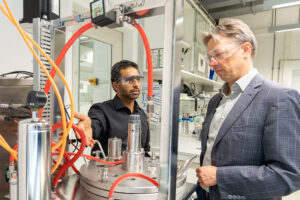New research approach at TUM campus Straubing to increase clean fuels
TUMCS | PM | 2023-06-13
Green hydrogen is considered as one of the most important energy carriers of the future and a beacon of hope for achieving climate neutrality – without having to restrict the availability of energy for Germany as an industrial location. The question of where and how the necessary quantity of hydrogen can be supplied has not yet been fully resolved. Scientists at the Technical University of Munich (TUM) have now come up with a new approach: They have now succeeded in redirecting biocatalytic synthesis processes so that they produce hydrogen as a byproduct. According to the researchers, this is only a small contribution – but every source should be considered in order to promote this alternative cheap and clean fuel in Germany and thus avoid CO2 emissions and the associated global warming.

Dr. Ammar Al-Shameri (left) and Prof. Dr. Volker Sieber in a laboratory of the Chair for Chemistry of Biogenic Resources. Photo: Jan Winter/TUM.
Specifically, scientists at the TUM Campus Straubing for Biotechnology and Sustainability (TUMCS) have combined an enzymatic reaction cascade for the conversion of xylose, an essential component of the biogenic waste material lignocellulose (plant cell walls), into monomers for bio-based polymers with so-called hydrogenases. Researchers are currently using these enzymes in particular to utilize hydrogen in biocatalysis.
TUM Future Lab conducts research on future hydrogen economy
“We reversed the direction of the reaction and were able to demonstrate the thermodynamically unfavorable reaction of hydrogen production, which was previously considered difficult or impossible” says study first author Dr. Ammar Al-Shameri from TUM’s Straubing campus. The scientist is the project leader at TUM’s future laboratory REDEFINE H2E – a collaborative effort led by TUM in which international experts from 13 countries are conducting research on various aspects of a future hydrogen economy, and which is currently funded by the German Federal Ministry of Education and Research (BMBF) with nearly five million euros.
Hydrogen production is actually only one of two aspects: Previously, oxygen was used as a co-substrate for the conversion processes described above. However, this led to considerable losses in the stability of the process and an increase in energy input.
Saving energy – and gaining an additional energy source at the same time
“With hydrogen co-production instead of oxygen input, we fill two needs with one deed,” says study leader Prof. Volker Sieber from the Chair of Chemistry of Biogenic Raw Materials at the TUM Straubing Campus and co-director of the REDEFINE H2E future lab. “Saving energy in the process and simultaneously producing an energy carrier makes the use of biogenic raw materials even more sustainable.” Coupling the production of a biogenic valuable material with hydrogen formation is another example of how the bioeconomy and hydrogen economy must go hand in hand to enable sustainable production processes.
A. Al-Shameri, D. L. Siebert, S. Sutiono, L. Lauterbach and V. Sieber (2023) “Hydrogenase-based Oxidative Biocatalysis without Oxygen” Nature Communications, 14, 2693.
